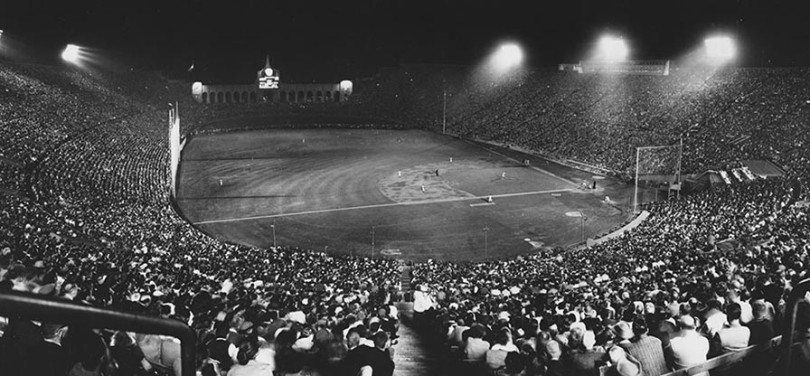
Reference Biography: Walter O’Malley
Where to Play in L.A.
Meanwhile, O’Malley continued to review his options for a future home.
On January 13, 1958, O’Malley and Don C. McMillan, Pasadena City Manager jointly issued a statement The Mirror News, Sports, January 14, 1958 regarding the failure of the Rose Bowl in Pasadena to accommodate the Dodgers’ needs.
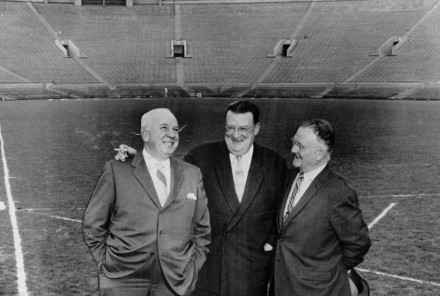
At the Rose Bowl in Pasadena, (L-R) National League President Warren Giles; Walter O’Malley; Pasadena City Manager Don McMillan stand where home plate could be located for baseball.
AP Photo
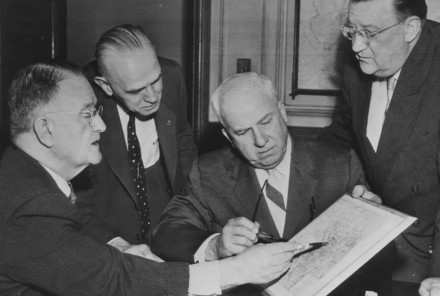
Obstacles with the Rose Bowl in Pasadena left Walter O’Malley two options to play in 1958 — Wrigley Field or the Los Angeles Memorial Coliseum. From left, Pasadena City Manager McMillan, Asst. City Manager Robert McCurdy, National League President Warren Giles and O’Malley.
AP Photo
“The cost of transforming the Rose Bowl into a major league stadium would amount to a minimum of $750,000,” the statement read. “The alteration would leave physical scars on the beautiful Rose Bowl. This amount of money could not be amortized in a short-term two-year lease after the payment of what in itself would be a substantial annual rent.
“In closing the negotiations Mr. McMillan expressed his deep admiration and appreciation of Mr. O’Malley and his fine staff who had worked long and diligently in a sincere effort to solve the overwhelming problems. It is our hope that all the citizens of Pasadena will give their complete and wholehearted support to the Dodgers’ organization in the solution of their problem and will continue their interest in our national sport of baseball.
“Mr. O’Malley is most appreciative of the courtesy of the Board of Directors of Pasadena in inviting the Dodgers to use the Rose Bowl. The City Manager’s staff has worked diligently to find a solution. Mr. O’Malley at this late hour feels constrained to select Wrigley Field as the site for the 1958 major league games.”
Another deterrent for playing in the Rose Bowl came from National League President Warren Giles, who wrote a letter to O’Malley on December 19, 1957, stating: “Press accounts indicate you will negotiate for the right to play some or all of your games in the Rose Bowl, which I understand is located within the city limits of Pasadena and of course outside the city limits of Los Angeles. There are two problems confronting us on that; one is very, very important. It is my belief that unless you would play a substantial number of your home games in a park located within the city limits of Los Angeles, the National League could not be considered as occupying Los Angeles territory in 1958. The other problem is, your club is considered to be the Los Angeles member of our league (or at least it will be when arrangements are finally completed) and therefore if you wanted to play a limited number of games outside of Los Angeles, league consent is required, just as it was in the Jersey City situation. Because of the park difficulties you are encountering, I feel the necessary consent to play a few games in Pasadena would be granted, but nevertheless it is a problem with which you are confronted. To play all of your games outside of Los Angeles would, in my judgment, leave the Los Angeles territory open and I am not sure but that some club might under our rules be able to move into Los Angeles, and at probably no cost to them. This would confront the league with a serious situation.” Letter to O’Malley from National League President Warren C. Giles, December 19, 1957
O’Malley in the meantime, reluctantly reviewed his own Wrigley Field property for possible use for the 1958 season, now less than three months away from Opening Day.
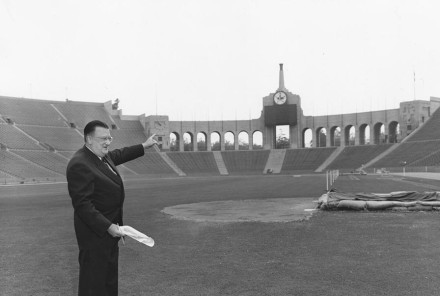
On May 2, 1957, Walter O’Malley surveys the mammoth Los Angeles Memorial Coliseum for temporary use by the Dodgers beginning with the 1958 season. He is standing where he believes home plate would be located.
Courtesy of University of Southern California, on behalf of the USC Specialized Libraries and Archival Collections
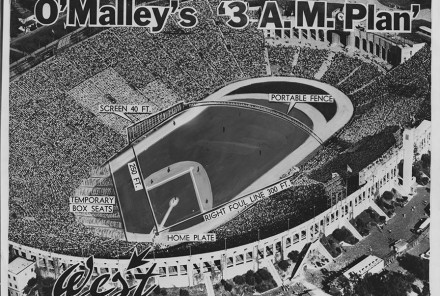
By installing a removable screen on the north side of the Coliseum, it was possible to configure the football layout into a makeshift baseball field. The “3 a.m. Plan” emerges in January 1958 from Walter O’Malley’s lack of sleep as he wrestles with options for where the Los Angeles Dodgers would play that year. The baseball diamond was to be shoehorned in the closed end of the Coliseum, giving home plate a north-east orientation. A 42-foot high screen had to be installed because of the short 251 foot left field fence.
On January 13, he enlisted the use of a police car to hustle from the failed negotiations in Pasadena, to Wrigley Field, some 13 miles away, to make another announcement. He felt “constrained to select Wrigley Field as the site for the 1958 major league games.” Los Angeles Examiner, January 14, 1958, AP But when pressed by reporters if that was his final decision, he said, “Well no. I’m not burning any bridges behind me.” O’Malley still wanted to pursue the 100,000-seat Coliseum, rather than 22,000-seat Wrigley Field, which could have been enlarged by some 1,600 to accommodate only 23,600 fans.
Strangely enough, one of the big drawbacks to L.A.’s Wrigley Field was a lack of parking (one lot holding just 800 cars attached to the park, with makeshift peripheral spaces on homeowners’ lawns), the same nagging issue he had tried to resolve at old Ebbets Field in Brooklyn. Plus, Ebbets Field held nearly 10,000 more fans than Wrigley Field’s capacity. O’Malley didn’t want to take a step backward for certain. He met later that day with Mayor Poulson to discuss ways to overcome opposition to the Dodgers playing in the Coliseum.
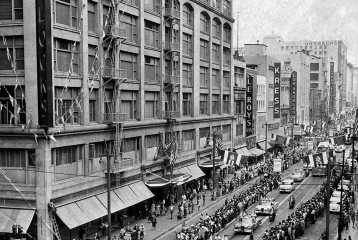
The Dodgers are welcomed to Los Angeles by thousands of fans on April 18, 1958, during an Opening Day parade and celebration through the city’s downtown streets.
Herald-Examiner Collection Los Angeles Public Library
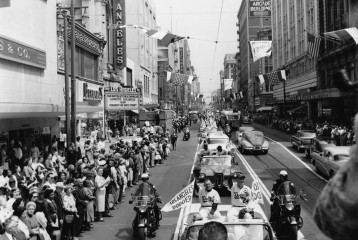
Thousands of fans lined the streets to greet their Los Angeles Dodgers, who traveled by motorcade to the Coliseum.
Courtesy of University of Southern California, on behalf of the USC Specialized Libraries and Archival Collections
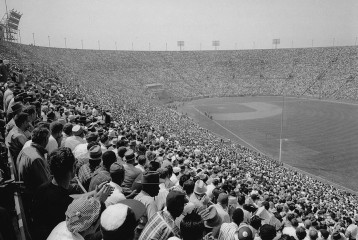
In the Dodgers’ first game in Los Angeles on April 18, 1958, they defeated the San Francisco Giants, 6-5, in front of an Opening Day major league record crowd of 78,672 fans at the Los Angeles Memorial Coliseum.
Following long, arduous meetings with the Coliseum Commission, O’Malley finally decided on using the Los Angeles Memorial Coliseum for his immediate needs, in an arrangement known as O’Malley’s “3 a.m. Plan.” This would enable the baseball diamond to be located on the west end of the Coliseum and did not remove any of the physical properties of the Coliseum. “This is made possible by erecting a screen on the north side of the Coliseum, a screen that would be removable,” Transcript of Recessed Meeting of L.A. Memorial Coliseum Commission, January 14, 1958, pg. 108 O’Malley said, plus his pledge to guarantee a rental fee per annum of $300,000, the highest ever paid by a baseball club.
The first modification was a 42-foot high screen that was erected in left field, to make up for a short 251-foot distance down the line. Additionally, a press box area in the stands, dugouts and three additional banks of lights would have to be added to the Coliseum. Foul territory would also be considerable in some areas.
After working out the details with the other co-tenants — the Los Angeles Rams, University of Southern California, UCLA, and others — O’Malley was ready to play in the classic stadium, though he made many sacrifices of typically lucrative home dates for the Dodgers, including the Fourth of July.
A massive downtown parade and welcoming ceremony on the steps of City Hall preceded the first game in Los Angeles, played on April 18, 1958 at the Coliseum and the Dodgers beat the San Francisco Giants, 6-5, before 78,672, a major league record crowd.
Ed Roebuck, pitcher for the Dodgers, perhaps said it best when describing the new surroundings and temporary home field: “It looks like Grand Canyon with seats.” Arthur Daley, The New York Times, April 18, 1958
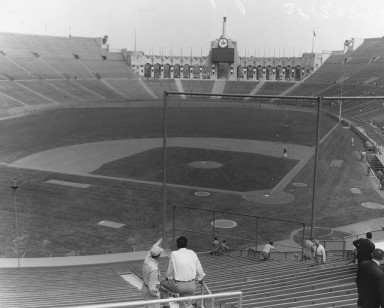
The makeshift baseball dimensions drew criticism from some circles, but the Coliseum’s unique features included an outfield wall that was higher than the one at the Polo Grounds.
Courtesy of University of Southern California, on behalf of the USC Specialized Libraries and Archival Collections
The short left field dimensions, dubbed “The Chinese Wall,” at 251 feet with a 42-foot high screen were instantly ridiculed primarily by East Coast writers who thought that no home run records should count from games played at the vast Coliseum. Some 60 percent of the nation’s sportswriters polled by Associated Press felt that all “future home run records achieved with the help of the nearby Coliseum fences be declared invalid.” Joe Reichler, Los Angeles Times, May 5, 1958
However, O’Malley explained the temporary stadium this way: “The Coliseum is a better ball park than the Polo Grounds and it’s better than Ebbets Field. There is a larger playing area here than in either of those parks. You can add up the square footage and prove it yourself. The fans are not complaining about left field. They know this is a temporary park, they accept it as such — and if I am any judge, they like all the excitement brought on by the screen.
“Furthermore, the Los Angeles press is understanding. Most of the complaints are from the eastern writers who lost National League newspaper assignments when we moved. If we had a chance to re-design the Coliseum as a temporary ball park, I believe we’d do everything the same way. It wouldn’t help to raise the screen much higher than 42 feet. For one thing, it has to be removable for football, under the terms of our contract, and it’s unwieldy enough as it is. For another thing, our screen as it stands today is 26 feet higher than the wall in the Polo Grounds. If that wall was adequate for a half century, this one ought to get by for two years.” Bob Oates, Los Angeles Examiner, April 21, 1958
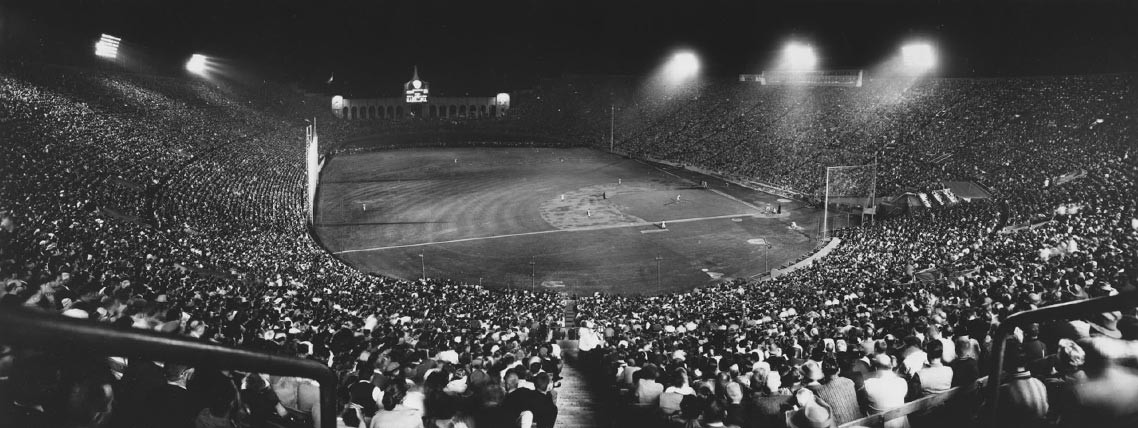
The Dodgers became an instant attraction at the Los Angeles Memorial Coliseum box office, drawing 1,845,556 fans in 1958.
Copyright © Los Angeles Dodgers, Inc.
He added on April 22, 1958 to Al Wolf of the Los Angeles Times, “The Coliseum, of course, is far from perfect for baseball. But it simply demonstrates the necessity for building a proper stadium, which is precisely what we want to do.” Al Wolf, Los Angeles Times, April 22, 1958
In Los Angeles, Examiner Sports Columnist Melvin Durslag pointed out, “You must remember it wasn’t the Dodgers’ idea to have a fence absurdly short in left field, absurdly long in right and interplanetary in center. This is what circumstances dictated. The Coliseum Commission greeted Walter O’Malley with something less than open arms. And the football tenants greeted him with arsenic over the rocks. First, the aesthetes stepped in and spoke with horror of anyone’s ‘defacing’ even a square foot of the stadium’s sacred concrete. Then the football people shuddered at the thought of a skinned area on the turf, and suggested home plate in the stadium’s eastern extremities.
“So there O’Malley stood, living at the moment outside the Coliseum and needing badly to get in. After inviting the Dodgers to Los Angeles, the city was on the doorsill of becoming a national disgrace by having our team play in Pasadena. The present playing field was a last-ditch inspiration which came to be known as ‘the 3 a.m. Plan,’ conceived at that hour only because O’Malley was immersed in his troubles instead of sleeping.” Melvin Durslag, Los Angeles Examiner, May 4, 1958

